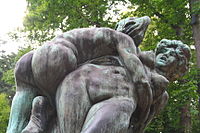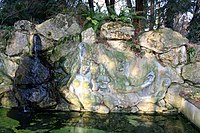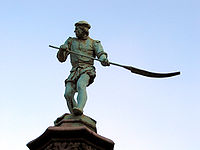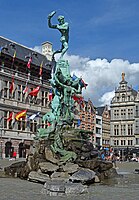Jef Lambeaux: Difference between revisions
m →Museum Jef Lambeaux: edit |
Kjell Knudde (talk | contribs) Added more categories. |
||
| (17 intermediate revisions by 16 users not shown) | |||
| Line 1: | Line 1: | ||
{{Short description|Belgian sculptor}} |
|||
| ⚫ | |||
{{Infobox artist |
{{Infobox artist |
||
| name = Jef Lambeaux |
| name = Jef Lambeaux |
||
| image = Jef Lambeaux.PNG |
| image = Jef Lambeaux.PNG |
||
| imagesize = 240 |
|||
| caption = Lambeaux, {{circa|1892}} |
| caption = Lambeaux, {{circa|1892}} |
||
| birth_name = Joseph Lambeaux |
| birth_name = Joseph Lambeaux |
||
| Line 18: | Line 19: | ||
}} |
}} |
||
'''Jef Lambeaux''' or '''Josef Lambeaux''' (14 January 1852 |
'''Jef Lambeaux''' or '''Josef Lambeaux''' (14 January 1852{{snd}}5 June 1908) was a [[Belgium|Belgian]] sculptor. His best known work is ''[[Temple of Human Passions]]'', a colossal [[marble]] [[bas-relief]]. |
||
==Early life and education== |
==Early life and education== |
||
Lambeaux was born in [[Antwerp]], [[Belgium]], on 14 January 1852. He studied at the [[Royal Academy of Fine Arts (Antwerp)|Antwerp Academy of Fine Arts]], and was a pupil of Jean Geefs. He was part of a group of young artists, the "Van Beers clique", led by [[Jan van Beers (artist)|Jan van Beers]]. This group included the artists [[Piet Verhaert]] (1852–1908) and [[Alexander Struys]] (1852–1941). They were well known for their mischievous and eccentric behaviour, including walking around Antwerp dressed in historic costumes.<ref name=RO>{{cite web|title=Jan van Beers, Belgian (1852–1927)|url=http://rogallery.com/van_Beers_Jan/van_beers-biography.html|work=rogallery.com|publisher=ROgallery|accessdate=8 March 2014}}</ref> |
Lambeaux was born in [[Antwerp]], [[Belgium]], on 14 January 1852. He studied at the [[Royal Academy of Fine Arts (Antwerp)|Antwerp Academy of Fine Arts]], and was a pupil of Jean Geefs.<ref name="EB1911">{{EB1911|inline=y|wstitle=Lambeaux, Jef|volume=18|page=106}}</ref> He was part of a group of young artists, the "Van Beers clique", led by [[Jan van Beers (artist)|Jan van Beers]]. This group included the artists [[Piet Verhaert]] (1852–1908) and [[Alexander Struys]] (1852–1941). They were well known for their mischievous and eccentric behaviour, including walking around Antwerp dressed in historic costumes.<ref name=RO>{{cite web|title=Jan van Beers, Belgian (1852–1927)|url=http://rogallery.com/van_Beers_Jan/van_beers-biography.html|work=rogallery.com|publisher=ROgallery|accessdate=8 March 2014}}</ref> |
||
==Career== |
==Career== |
||
[[File:Temple of Human Passions.jpg|thumb|right| |
[[File:Temple of Human Passions.jpg|thumb|right|290px|''Temple of Human Passions'' (1898)]] |
||
His first work, ''War'', was exhibited in 1871, and was followed by a long series of humorous groups, including ''Children Dancing, Say Good Morning, The Lucky Number'' and; ''An Accident'' (1875). He then went to [[Paris]], where he executed ''The Beggar and The Blini Pauper'' for the Belgian salons, and produced ''The Kiss'' (1881), generally regarded as his masterpiece. [[Claire Colinet|Claire J. R. Colinet]] – who would have great success during her career in the [[Art Deco]] era – was one of Lambeaux's students during his time in Paris.<ref name="AskArt">{{cite web |title=Claire Jeanne Roberte Colinet |url=http://www.askart.com/artist/Claire_Jeanne_Roberte_Colinet/11094641/Claire_Jeanne_Roberte_Colinet.aspx |
His first work, ''War'', was exhibited in 1871, and was followed by a long series of humorous groups, including ''Children Dancing, Say Good Morning, The Lucky Number'' and; ''An Accident'' (1875). He then went to [[Paris]], where he executed ''The Beggar and The Blini Pauper'' for the Belgian salons, and produced ''The Kiss'' (1881), generally regarded as his masterpiece. [[Claire Colinet|Claire J. R. Colinet]] – who would have great success during her career in the [[Art Deco]] era – was one of Lambeaux's students during his time in Paris.<ref name="AskArt">{{cite web |title=Claire Jeanne Roberte Colinet |url=http://www.askart.com/artist/Claire_Jeanne_Roberte_Colinet/11094641/Claire_Jeanne_Roberte_Colinet.aspx |website=AskArt.com |accessdate=28 January 2016}}</ref> After visiting [[Italy]], where he was much impressed by the works of [[Jean Boulogne]], he showed a strong predilection for effects of force and motion.<ref name="EB1911"/> |
||
|website=AskArt.com |accessdate=January 28, 2016}}</ref> After visiting [[Italy]], where he was much impressed by the works of [[Jean Boulogne]], he showed a strong predilection for effects of force and motion. |
|||
Other notable works include his [[ |
Other notable works include his [[Brabo Fountain]] in Antwerp (1886), ''Robbing the Eagles Eyrie'' (1890), ''Drunkenness'' (1893), ''The Triumph of Woman'', ''The Bitten Faun'' (which created a great stir at the Exposition Universelle at [[Liège]] in 1905), and ''[[Temple of Human Passions|The Human Passions]]'', a colossal [[marble]] [[bas-relief]], elaborated from a sketch exhibited in 1889. Of his numerous busts may be mentioned those of [[Hendrik Conscience]], and of [[Charles Buls]], the [[burgomaster]] of [[Brussels]].<ref name="EB1911"/><ref name=Sothebys>''Nineteenth Century Decorative Arts.'' 1984. London: Sotheby's, p. 442.</ref><ref name=Catley>Catley, Bryan. 2003. ''Art Deco and Other Figures.'' Woodbridge, UK: Antique Collectors Club Limited, p. 390.</ref> |
||
===''Temple of Human Passions''=== |
===''Temple of Human Passions''=== |
||
Lambeaux didn't escape the wrath of art critics when he showed a life-size model of ''Temple of Human Passions'' at the Salon Triennial in [[Ghent]] in 1889. The sculpture managed to attract such fury and uproar that in 1890 the journal ''L’Art Moderne'' described the work as follows: |
Lambeaux didn't escape the wrath of art critics when he showed a life-size model of ''Temple of Human Passions'' at the Salon Triennial in [[Ghent]] in 1889. The sculpture managed to attract such fury and uproar that in 1890 the journal ''L’Art Moderne'' described the work as follows: |
||
{{Quote|text= |
{{Quote|text=[It is] a pile of naked and contorted bodies, muscled wrestlers in delirium, an absolute and incomparable childish concept. It is at once chaotic and vague, bloated and pretentious, pompous and empty. And what if, instead of paying for 300,000 francs of "passions", the government simply bought works of art?<ref name="Wordpress">{{cite web |title=Jeff Lambeaux: The Temple of Human Passions |url=https://liabxl.wordpress.com/tag/jef-lambeaux/ |website=WordPress.com |accessdate=28 January 2016}}</ref>}} |
||
==Death== |
==Death== |
||
Lambeaux died on 5 June 1908 in [[Brussels]].<ref name=Sothebys /><ref name=Catley /> |
Lambeaux died on 5 June 1908 in [[Brussels]].<ref name=Sothebys /><ref name=Catley /> |
||
== Honours == |
|||
* 1887: Knight in the [[Order of Leopold (Belgium)|Order of Leopold]].<ref>Handelsblad (Het) 06-01-1887</ref> |
|||
==Gallery== |
==Gallery== |
||
<gallery widths="200" heights="200"> |
<gallery widths="200" heights="200"> |
||
File:Mariemont_Lambeaux_JPG1a.jpg|''Le Triomphe de la Femme'' (1901) |
|||
File:Temple of Human Passions.jpg|''Temple of Human Passions'' (1898) |
|||
File:Jef Lambeaux JPG1c.jpg|''Le Triomphe de la Femme'' (1901) |
File:Jef Lambeaux JPG1c.jpg|''Le Triomphe de la Femme'' (1901) |
||
File:Morlanwelz Mariemont JPG12.jpg|''The Joy'' bas relief fragment of ''The Human Passions'' |
|||
File:Mariemont_Lambeaux_JPG2a.jpg|''L'Abondance'' (1902) |
|||
File:0 Bruxelles - Petit Sablon - Blanchisseur.JPG|''Le Blanchisseur'' ({{lang-en|launderer or bleacher}}) |
File:0 Bruxelles - Petit Sablon - Blanchisseur.JPG|''Le Blanchisseur'' ({{lang-en|launderer or bleacher}}) |
||
File:Cathedral of our Lady 9 (Piotr Kuczynski).jpg|[[Cathedral of Our Lady, Antwerp]] |
File:Cathedral of our Lady 9 (Piotr Kuczynski).jpg|[[Cathedral of Our Lady, Antwerp]] |
||
File:Antwerp Brabofontein 017 8004.jpg|''[[Brabo Fountain|Brabo]]'' (1886) |
|||
</gallery> |
</gallery> |
||
| Line 56: | Line 59: | ||
== Notes == |
== Notes == |
||
{{reflist}} |
{{reflist}} |
||
== References == |
|||
* {{EB1911|title=Lambeaux, Jef |url=http://encyclopedia.jrank.org/KRO_LAP/LAMBEAUX_JEF_JOSEPH_MARIE_THOMA.html}} |
|||
{{Commons category|Jef Lambeaux}} |
{{Commons category|Jef Lambeaux}} |
||
{{ACArt}} |
|||
{{Authority control}} |
|||
Alain Jacobs, https://collections.heritage.brussels/fr/objects/42758 [archive]https://collections.heritage.brussels/fr/objects/42760 [archive] https://collections.heritage.brussels/fr/objects/4275 [archive]9 [archive]https://collections.heritage.brussels/fr/objects/42761 [archive] |
|||
| ⚫ | |||
{{Persondata <!-- Metadata: see [[Wikipedia:Persondata]]. --> |
|||
| NAME =Lambeaux, Jef |
|||
| ALTERNATIVE NAMES = |
|||
| SHORT DESCRIPTION =sculptor |
|||
| DATE OF BIRTH =14 January 1852 |
|||
| PLACE OF BIRTH =[[Antwerp]], Belgium |
|||
| DATE OF DEATH =5 June 1908 |
|||
| PLACE OF DEATH =[[Brussels]], Belgium |
|||
}} |
|||
{{DEFAULTSORT:Lambeaux, Jef}} |
{{DEFAULTSORT:Lambeaux, Jef}} |
||
[[Category: |
[[Category:Jef Lambeaux| ]] |
||
[[Category:19th-century Belgian sculptors]] |
|||
[[Category:20th-century Belgian sculptors]] |
|||
[[Category:Belgian male sculptors]] |
|||
[[Category:1852 births]] |
[[Category:1852 births]] |
||
[[Category:1908 deaths]] |
[[Category:1908 deaths]] |
||
[[Category: |
[[Category:Artists from Antwerp]] |
||
[[Category:Jef Lambeaux]] |
|||
[[Category:Royal Academy of Fine Arts (Antwerp) alumni]] |
[[Category:Royal Academy of Fine Arts (Antwerp) alumni]] |
||
Latest revision as of 16:42, 25 October 2023
Jef Lambeaux | |
|---|---|
Lambeaux, c. 1892 | |
| Born | Joseph Lambeaux 14 January 1852 |
| Died | 5 June 1908 (aged 56) Brussels, Belgium |
| Nationality | Belgian |
| Bildung | Studied under Jean Geefs |
| Known for | Sculpture |
| Notable work | Temple of Human Passions |
Jef Lambeaux or Josef Lambeaux (14 January 1852 – 5 June 1908) was a Belgian sculptor. His best known work is Temple of Human Passions, a colossal marble bas-relief.
Early life and education
[edit]Lambeaux was born in Antwerp, Belgium, on 14 January 1852. He studied at the Antwerp Academy of Fine Arts, and was a pupil of Jean Geefs.[1] He was part of a group of young artists, the "Van Beers clique", led by Jan van Beers. This group included the artists Piet Verhaert (1852–1908) and Alexander Struys (1852–1941). They were well known for their mischievous and eccentric behaviour, including walking around Antwerp dressed in historic costumes.[2]
Career
[edit]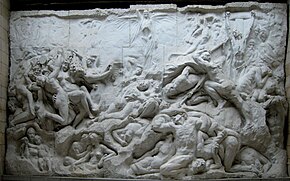
His first work, War, was exhibited in 1871, and was followed by a long series of humorous groups, including Children Dancing, Say Good Morning, The Lucky Number and; An Accident (1875). He then went to Paris, where he executed The Beggar and The Blini Pauper for the Belgian salons, and produced The Kiss (1881), generally regarded as his masterpiece. Claire J. R. Colinet – who would have great success during her career in the Art Deco era – was one of Lambeaux's students during his time in Paris.[3] After visiting Italy, where he was much impressed by the works of Jean Boulogne, he showed a strong predilection for effects of force and motion.[1]
Other notable works include his Brabo Fountain in Antwerp (1886), Robbing the Eagles Eyrie (1890), Drunkenness (1893), The Triumph of Woman, The Bitten Faun (which created a great stir at the Exposition Universelle at Liège in 1905), and The Human Passions, a colossal marble bas-relief, elaborated from a sketch exhibited in 1889. Of his numerous busts may be mentioned those of Hendrik Conscience, and of Charles Buls, the burgomaster of Brussels.[1][4][5]
Temple of Human Passions
[edit]Lambeaux didn't escape the wrath of art critics when he showed a life-size model of Temple of Human Passions at the Salon Triennial in Ghent in 1889. The sculpture managed to attract such fury and uproar that in 1890 the journal L’Art Moderne described the work as follows:
[It is] a pile of naked and contorted bodies, muscled wrestlers in delirium, an absolute and incomparable childish concept. It is at once chaotic and vague, bloated and pretentious, pompous and empty. And what if, instead of paying for 300,000 francs of "passions", the government simply bought works of art?[6]
Death
[edit]Lambeaux died on 5 June 1908 in Brussels.[4][5]
Honours
[edit]- 1887: Knight in the Order of Leopold.[7]
Gallery
[edit]-
Le Triomphe de la Femme (1901)
-
Temple of Human Passions (1898)
-
Le Triomphe de la Femme (1901)
-
The Joy bas relief fragment of The Human Passions
-
L'Abondance (1902)
-
Le Blanchisseur (English: launderer or bleacher)
-
Brabo (1886)
Jef Lambeaux Museum
[edit]In 2006 the association "ASBL Musée Jef Lambeaux" was set up to promote the creation of a museum dedicated to the artist in Saint-Gilles, Belgium.[8] The museum was already promised by the municipality of Saint-Gilles in 1898 but never built.[9]
Notes
[edit]- ^ a b c One or more of the preceding sentences incorporates text from a publication now in the public domain: Chisholm, Hugh, ed. (1911). "Lambeaux, Jef". Encyclopædia Britannica. Vol. 18 (11th ed.). Cambridge University Press. p. 106.
- ^ "Jan van Beers, Belgian (1852–1927)". rogallery.com. ROgallery. Retrieved 8 March 2014.
- ^ "Claire Jeanne Roberte Colinet". AskArt.com. Retrieved 28 January 2016.
- ^ a b Nineteenth Century Decorative Arts. 1984. London: Sotheby's, p. 442.
- ^ a b Catley, Bryan. 2003. Art Deco and Other Figures. Woodbridge, UK: Antique Collectors Club Limited, p. 390.
- ^ "Jeff Lambeaux: The Temple of Human Passions". WordPress.com. Retrieved 28 January 2016.
- ^ Handelsblad (Het) 06-01-1887
- ^ Leclercq, Philippe. "Amusez Lambeaux" (in French). asbl Musée Jef Lambeaux. Retrieved 21 January 2009.
- ^ Bernier, Fernand (1904). "Le futur musée Jef Lambeaux". In Weissenbruch (ed.). Monographie de Saint-Gilles lez-Bruxelles - Histoire et description illustrées (in French). Brussels. pp. 291–294. OCLC 80713780.
{{cite book}}: CS1 maint: location missing publisher (link)
Alain Jacobs, https://collections.heritage.brussels/fr/objects/42758 [archive]https://collections.heritage.brussels/fr/objects/42760 [archive] https://collections.heritage.brussels/fr/objects/4275 [archive]9 [archive]https://collections.heritage.brussels/fr/objects/42761 [archive]



